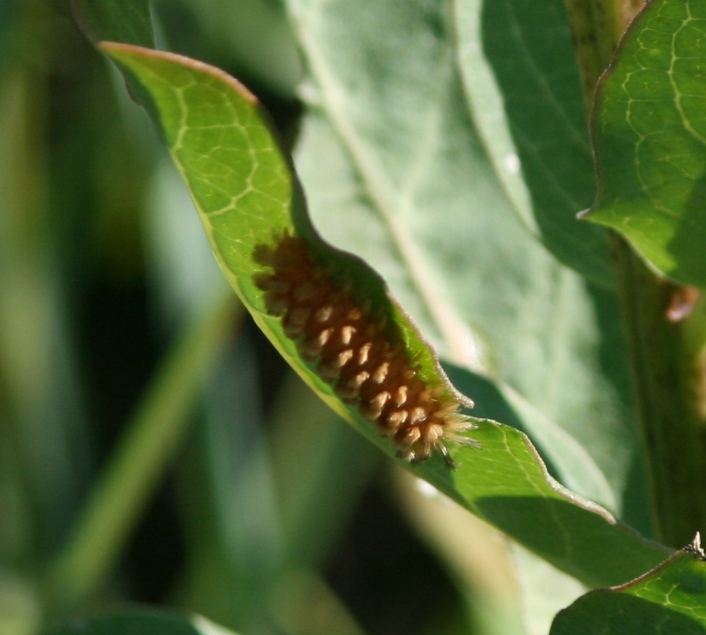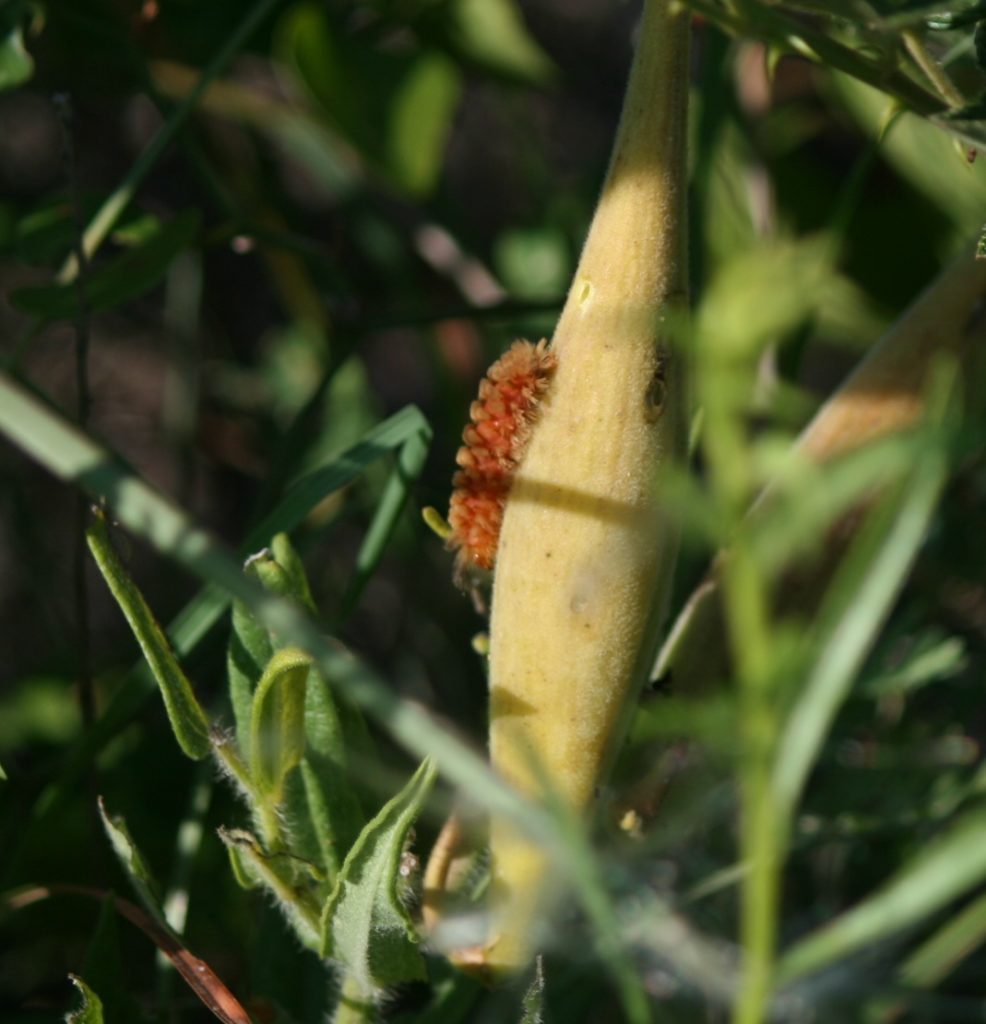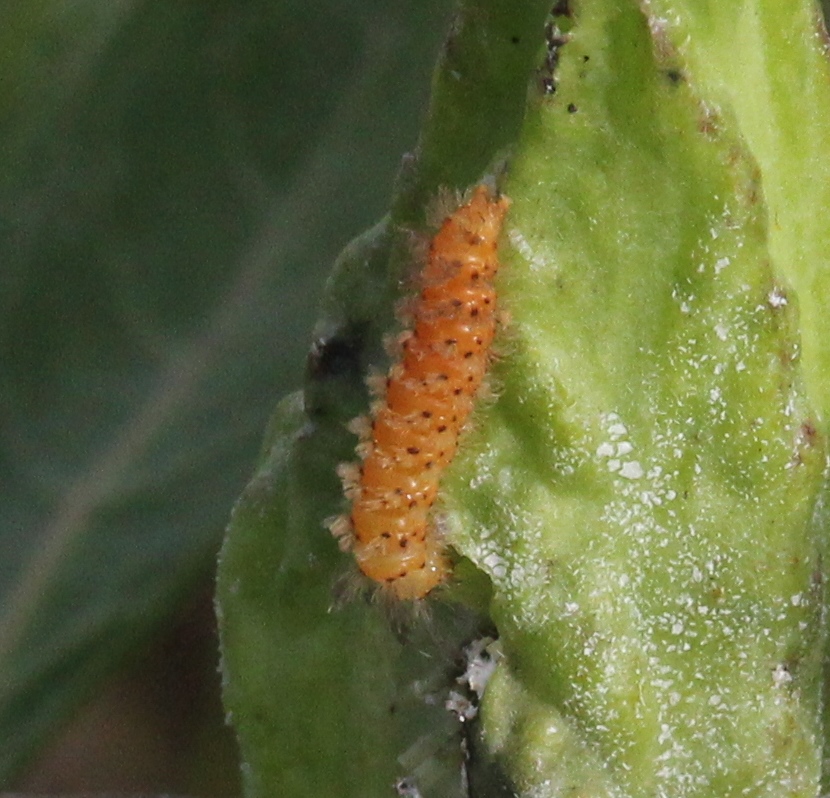The first time I saw a caterpillar like this on one of my milkweeds it was the last day of June, 2012, and I was out in the stifling heat and humidity at the farm “botanizing” with the incomparable Sonnia Hill.

With a little looking, we found about a dozen more, all eating my milkweed plants, but dining on several different species of milkweed. The crazy things were bright peachy orange, with eyelash shaped tufts of fuzz all over their caterpillar bodies. They looked like a bit of Grandmother’s chenille bedspread, or some kind of craft supply. Whatever they were, we could see they were really munching down on all the slim leaved species of milkweeds on the farm.
And also on the Green Milkweed (Asclepias viridis), with its much broader leaves,

and even the Butterflyweed (Asclepias tuberosa). They ate the leaves and the pods.

We even found some that had eaten all the leaves and were munching the stems of the slimmer milkweeds. It seemed they weren’t picky as long as it was milkweed.
2012 was the year that I went through with a major camera setting fairly maladjusted for a few months. My allergies are so bad this time of year that I really can’t tell when I’m out in the field if things are in focus or not. I shoot and hope for the best. In 2012, with that one setting out of whack, I kept returning with disappointing photos. My photos of these amazing orange muppet sticks left a lot to be desired, but I had just enough to hunt down an ID for the beasties. It turned out that wasn’t so simple. It took me about two weeks to find someone who really knew for sure what they were, and the answer surprised me. They were Unexpected. More specifically, they were the Unexpected Cycnia Moth caterpillars. Seriously—that’s their actual name –the Unexpected Cycnia Moth, Cycnia inopinatus .
Why Unexpected? Well, it’s what they do, or maybe more accurately, what they don’t do. They don’t seem to show up in the same places year after year. Sightings of them are occasional at best, and in Texas, at least in 2012, they had been very rarely seen. There had only ever been a handful of reported sightings in the state I was told. Checking the Butterflies and Moths of North America page, I see they are still not regularly seen in Texas (view here: https://www.butterfliesandmoths.org/species/Cycnia-inopinatus) It looks like taxonomists have been at work again, and Cycnia inopinatus is now considered an older synonym for Cycnia collaris, to further confuse the issue.
Mine weren’t even the color most often seen. They were the lovely orange and not the brownish shown in a lot of the photos on the BAMONA page. No wonder they were hard to ID! It was a true oddity, and not one often documented for this region.
These caterpillars become moths, but the species in not well studied because it’s very hard to predict where they will turn up, and they usually aren’t seen in large numbers. So really, not only are they unexpected—they’re inscrutable and mysterious. Nobody really knew much about their lifestyles and habits in 2012. Maybe they still don’t. What we do know is that their cousins, a different species of Cycnia Moth, have the ability to emit a series of clicks that are perfectly timed to fool a bat’s echolocation systems as the bat closes in for the kill. Those clicks are life savers for the moths, allowing them to escape the bats’ predations most of the time. How cool is that!?

Today, I was again delighted by the Unexpected. I had guests at the farm, a father/daughter pair of outstanding photographers, and I had outfitted my own camera with a fixed lens that doesn’t let me get any closer than about 6 feet from my subject. It’s a good lens for shooting butterflies, bees and dragonflies, my targets for the day, but not so grand for flowers and caterpillars down in the grass.

So there I was, when the Unexpected struck again, with the wrong lens. Given the amount of Saharan dust in the air today, I don’t know if I would have tried to change lenses in the field even if I had had a caterpillar lens with me, but I should know by now, when the cicadas start singing, when midday outings are unbearably hot, when the milkweeds are full of pods, when Copperheads seek the cool of the barn floor, I should expect the Unexpecteds, and be ready.